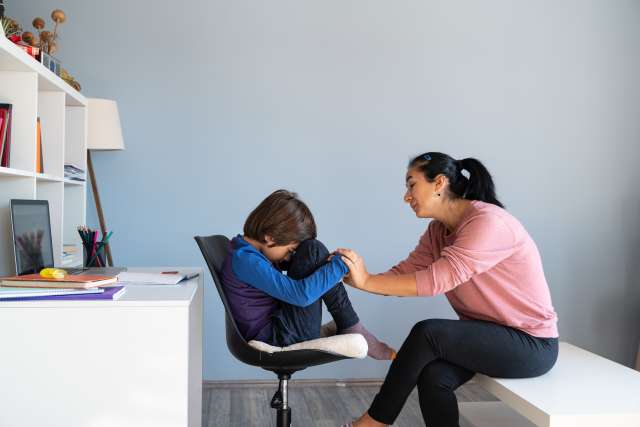Anxiety and depression among young people has increased since the early days of the COVID-19 pandemic, doubling according to some estimates. But it’s not always easy to distinguish potentially problematic anxiety from normal, everyday worries.
“Anxiety is completely and absolutely normal,” says John Piacentini, PhD, a child and adolescent psychologist with UCLA Health. “Anxiety is one of the most helpful emotions that we have.”
That fight-or-flight feeling is anxiety, he said, which “evolved over time to keep us safe.”
Anxiety becomes problematic when it arises in the absence of danger. Excessive anxiety is often the first problem to emerge among troubled teens (or adults), Dr. Piacentini said at a about teen mental health sponsored by the .
“When their anxiety goes off, they interpret situations that others might think would be positive as being potentially dangerous,” he said. “For example, most kids want to go to birthday parties and see friends. Most kids want to go to Six Flags. Anxious kids don’t want to do any of those things because they’re terrified for different kinds of reasons.”
Anxiety is the most common child psychiatric disorder, according to the U.S. Surgeon General’s report on youth mental health, affecting 12% to 20% of children. Anxiety goes from normal to a level that may benefit from treatment when it interferes with a person’s everyday life, Dr. Piacentini said, either because anxious episodes become more frequent or reactions become more intense.
“When anxiety gets to the point where the children involved aren’t really able to function, it becomes severely disruptive for the family, the child becomes isolated or they become depressed, then we start thinking about the need for treatment,” said Dr. Piacentini, director of the and the .
Early intervention for anxiety can have positive effects in preventing depression, suicidal thoughts and substance use, he added.
Dr. Piacentini gives a on recognizing and treating problematic fear and anxiety in children on the .
Some questions parents or caregivers can ask themselves, to help clarify if a child may have an anxiety disorder, include:
- Does the child worry or ask for parental assurance almost every day?
- Does the child consistently avoid certain age-appropriate activities or situations (such as soccer practice or birthday parties), or avoid doing them without a parent?
- Does the child frequently have headaches, stomachaches or episodes of hyperventilation?
- Does the child have daily repetitive rituals (such as handwashing or the need to organize things in certain ways)?
Anxious children are likely to have at least one anxious parent, Dr. Piacentini said: “When we see our kids struggling with anxiety, that makes us anxious, and we start doing all the things we don’t want them to do.” So remaining calm is essential.
He suggests the following ways to support a young person dealing with anxiety:
- Listen with empathy and without judgement. Caregivers may want to intervene on behalf of an anxious child (“Did that kid bully you again? I’m going down to the school to take care of this.”) but it’s important to instead practice patience and compassion, Dr. Piacentini said. Ask open-ended questions and actively listen to the child’s answers.
- Avoid giving into fear and avoidance behaviors. A child with anxiety may try to resist going to school, but if throwing a tantrum allows them to stay home, this reinforces negative behaviors, Dr. Piacentini said. Be calm but firm and insist that they go to school or any other scheduled, age-appropriate activity.
- Catch kids being courageous. Parents and caregivers may be quick to notice episodes of anxiety in the young people in their lives, but it’s also important to recognize instances of healthy behaviors. Celebrate a child when they take on new challenges or overcome fears.
- Share personal experiences. “It can be very helpful for kids for parents to self-disclose a little bit,” Dr. Piacentini said. For example, a parent might share that they also used to be nervous about going to birthday parties when they were little, but after talking to their mom and dad about it, they felt a little better and ended up having fun at the party with their friends.




